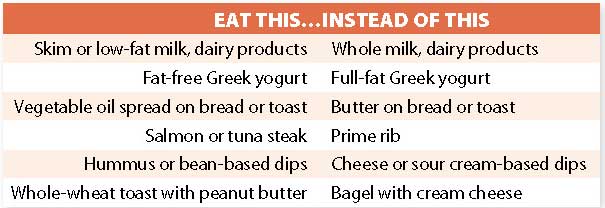Dietary Fats: It’s Not the Amount but the Type That Counts
You read and hear a lot about dietary fats these days: Some are “good,” some are “bad,” and there are conflicting recommendations about how much is safe to eat. Many consumers are confused by all this information about the different types of fats and how to implement these recommendations into their diets. How do you sort this out when you’re planning meals?
Healthy vs. Unhealthy
To make sense of the fat puzzle, it’s best to start with the basics. So-called “healthy” fats are monounsaturated and polyunsaturated fats. They come mostly from plant sources but are found in some animal-sourced foods, too. Unsaturated fats are liquid at room temperature.
Saturated fats are solid at room temperature and are considered “unhealthy” fats. They come primarily from animal sources but also are found in a few plant products.
Trans fats found in processed foods are also considered unhealthy. Industrial trans fats are created through the chemical process of partial hydrogenation, which alters cooking oils to make them solid at room temperature. The U.S. Food & Drug Administration has directed food manufacturers to stop using these partially hydrogenated oils, saying that removing these oils from processed foods could prevent thousands of heart attacks and deaths each year. (Small amounts of natural trans fats are present in meat and dairy products, but these fats have not been associated with the same health risks as industrially produced trans fats.)
“A great deal of research suggests that getting the majority of your fat from unsaturated fats, both polyunsaturated and monounsaturated fats, is more heart-healthy than consuming saturated or trans fats,” says Jenna Rosenfeld, MS, RD, CDN, CNSC, a registered dietitian at NewYork-Presbyterian/Weill Cornell. For example, one study found that a diet higher in saturated fat—the type found in red meat, full-fat dairy products, lard, and palm oil, significantly raised the risk for developing coronary heart disease.
Rosenfeld notes that it’s hard to completely escape saturated fats, even when you’re making healthy choices. “Almost all sources of fats, from oils to nuts, contain a mix of all types of fat. Rather than trying to eliminate all saturated fat from your diet, replace it with healthier fats,” she says.
Fats in Food
The most common sources of saturated fats are whole-fat dairy products, red meat (beef, pork, and veal), and processed meat (cold cuts, bacon, sausage, hot dogs). Plant products that are high in saturated fat include palm, palm kernel, and coconut oils.
Trans fats must be phased out of the food supply by the middle of 2018; until then, check the ingredient lists of processed foods, including snack foods, baked goods, margarine, and microwave popcorn. Look for “partially hydrogenated oil” (the source of trans fat in processed foods) in the ingredient list to ensure that you’re avoiding this unhealthy fat completely. Trans fat is unequivocally linked to an increased risk of heart disease.
Unsaturated fats are found in many plant-based oils, including olive, canola, soybean, sunflower, peanut, and flaxseed oils, as well as in nuts, seeds, fish, and avocados. Healthy fats have been linked with decreased risks of death, heart disease, cancer, neurodegenerative disease, and respiratory disease.”
Make Smart Swaps
To replace unhealthy fats with healthier fats, you have many options. “Choose salmon or tuna instead of red meat for dinner twice a week,” suggests Rosenfeld. “Put avocado slices on your sandwich instead of mayonnaise, and add almonds or walnuts to your salad, or just have them as a snack. By replacing both saturated fats and refined carbohydrates with unsaturated fats, you can lower your cholesterol numbers and reduce your risk for cardiovascular disease.”

The post Dietary Fats: It’s Not the Amount but the Type That Counts appeared first on University Health News.
Read Original Article: Dietary Fats: It’s Not the Amount but the Type That Counts »
Powered by WPeMatico

